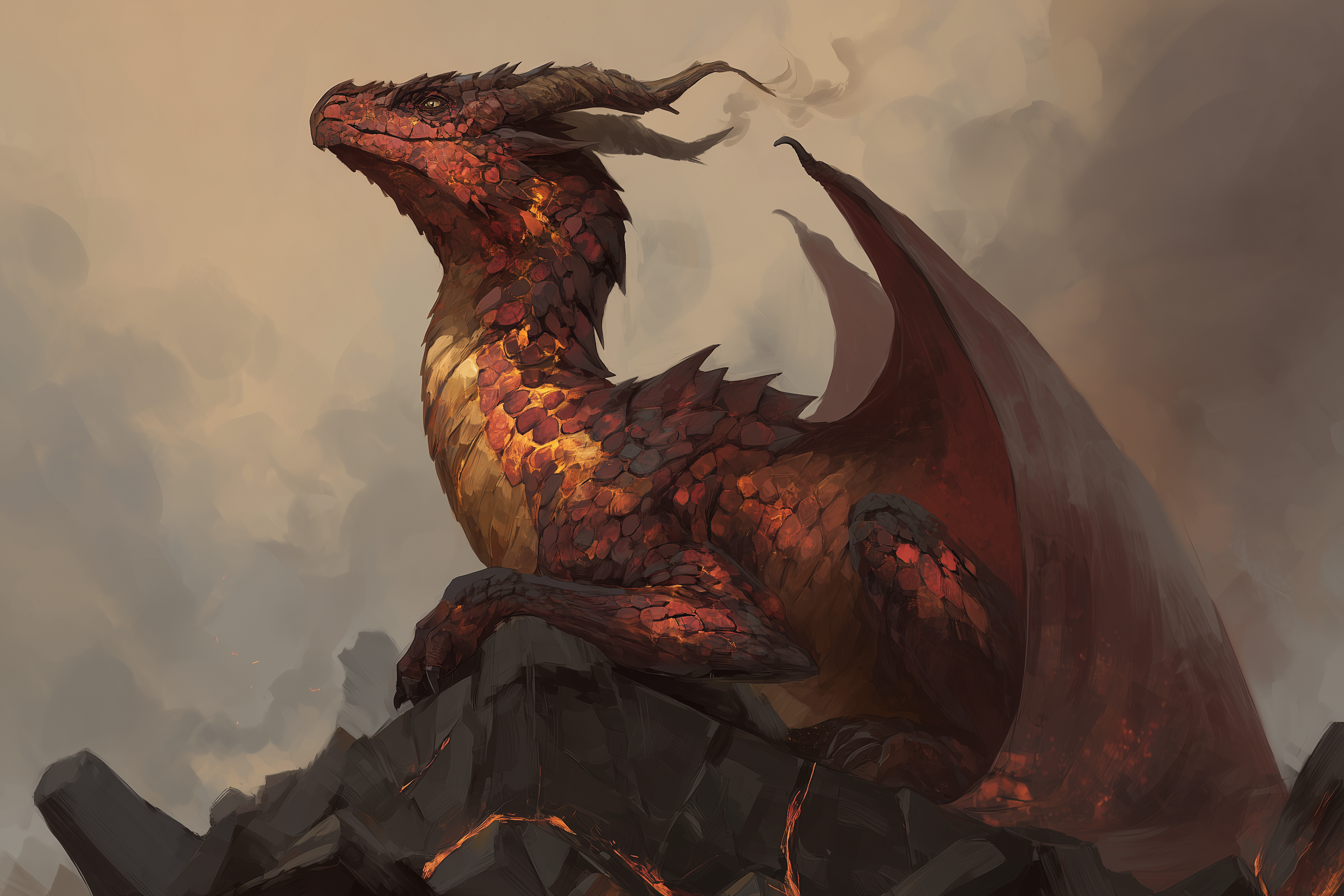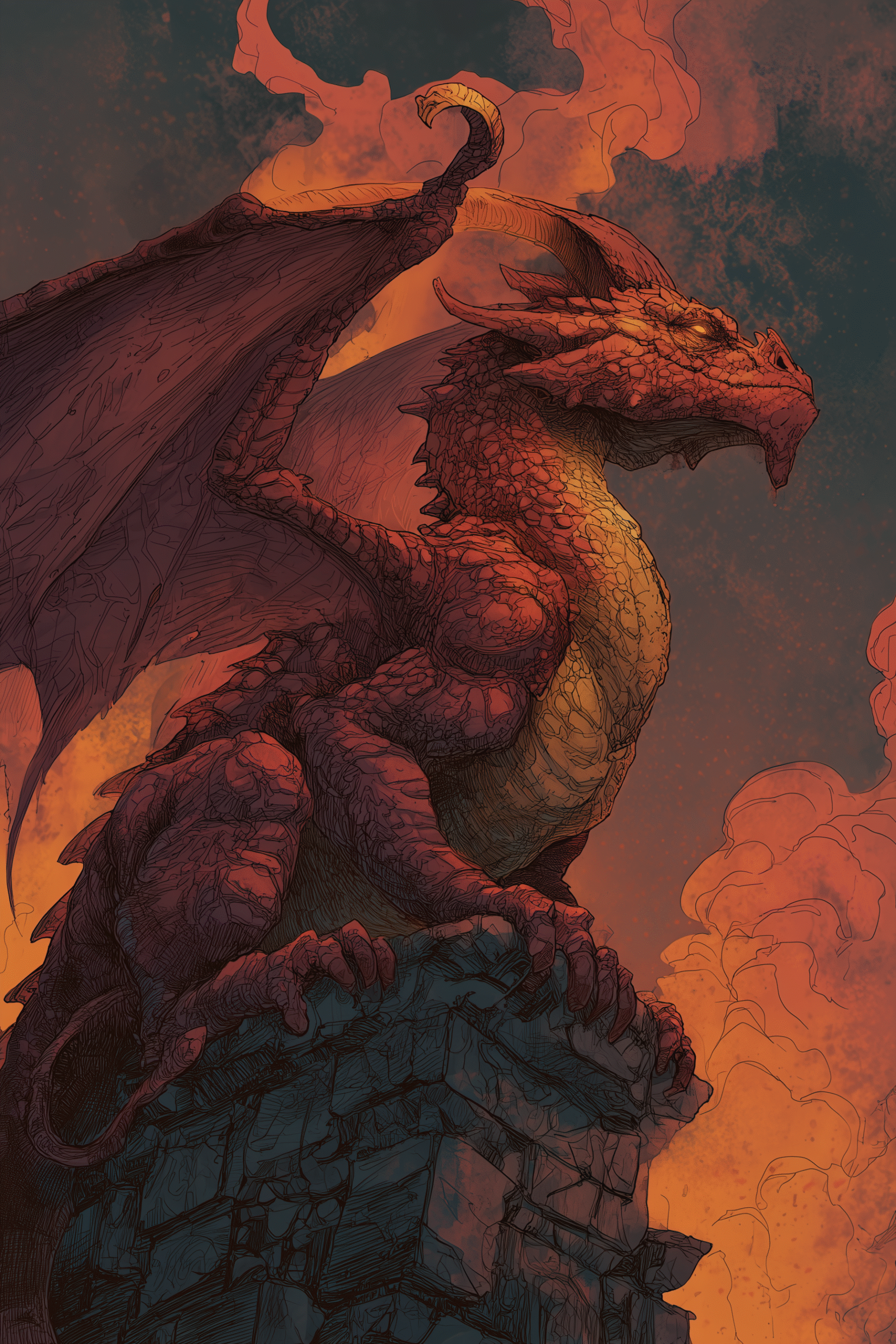Fire Drake, “Heart of the Furnace”
“The Fire Drake: a small dragon with a big temper—its breath burns, and its blood explodes.”
The Fire Drake is a small, quadrupedal dragon measuring between 4 to 6 feet in length, with a long, whip-like tail and narrow snout lined with needle-like teeth. Its scales are semi-translucent and shimmer with internal heat, ranging in color from burgundy to burnt mauve, often flecked with ash-gray patterns. Thin membranes stretch across mottled black wings, giving it a ghostly silhouette when airborne against smoke or dusk. Crimson eyes glow with an ember-like intensity, often the first warning of its presence. When wounded, gouts of flame-colored blood erupt in bursts of fire, burning anything nearby.
Behavior
Fire Drakes are solitary and intensely territorial. Though smaller than true dragons, they possess an inflated sense of dominance and will engage perceived threats or rivals without hesitation. They are clever enough to recognize patterns in prey movement and will ambush or harass from the air before committing to full combat. While not inherently evil, Fire Drakes are impulsive and prone to sudden outbursts of violence—especially if provoked or defending a lair.
They exhibit a curious fascination with fire, often playing with embers, coals, or lava flows when not hunting. In rare moments of calm, they are known to bask in volcanic vents or sunlit rock faces, exuding contented plumes of steam.
Habitat
Fire Drakes inhabit temperate hills, volcanic highlands, or geothermal cave systems, where warmth and isolation abound. Their lairs are typically in natural caverns, hollowed-out lava tubes, or abandoned ruins near thermal activity. Entrances are often marked by scorched rock, melted foliage, or piles of charred bones. They prefer elevated positions and narrow cave mouths they can easily defend.
Modus Operandi
A Fire Drake prefers to initiate combat with a sudden breath of flame—a 20-foot cone of fire capable of incinerating front-line attackers. Afterward, it strafes or darts with aerial agility, harrying opponents with bite attacks while avoiding melee entanglement. The drake’s pyrophoric blood acts as a secondary deterrent, burning melee attackers who wound it. If overwhelmed, it will retreat into cramped tunnels or soar away to regroup.
Drakes are not above using their environment to their advantage—collapsing a ledge, igniting a flammable patch of terrain, or luring enemies into geothermal hazards if such opportunities exist.
Motivation
Though lacking the scheming intelligence of greater dragons, Fire Drakes are driven by instinctive desires:
- Territory: They fiercely guard their domains, especially during mating season.
- Heat: They are drawn to sources of fire or magic related to flame.
- Hoarding: Not true hoarders like chromatic dragons, Fire Drakes still collect shiny, heat-resistant objects—especially those with fiery enchantments or alchemical value.
- Survival: Above all, they value their continued dominance in an area and will eliminate anything that threatens their position or safety.
They are occasionally courted or bound by fire cults, alchemists, or reckless summoners for their blood and breath, though rarely willingly.
Fire Drake 5e
Fire Drake, Pathfinder
Fire Drake

Small Dragon (Fire), Chaotic Neutral
Challenge 3 (700 XP) • Proficiency Bonus +2
Armor Class 15 (natural armor)
Hit Points 52 (8d6 + 24)
Speed 30 ft., fly 60 ft. (average)
| STR | DEX | CON | INT | WIS | CHA |
|---|---|---|---|---|---|
| 13 (+1) | 15 (+2) | 16 (+3) | 6 (−2) | 12 (+1) | 11 (+0) |
Saving Throws Dexterity +4, Constitution +5, Wisdom +3
Skills Perception +5, Stealth +6, Athletics +3
Damage Immunities Fire
Damage Vulnerabilities Cold
Condition Immunities Charmed, Frightened, Paralyzed, Sleep
Senses Darkvision 60 ft., Passive Perception 15
Languages Draconic
Traits
Pyrophoric Blood (Reactive).
When the fire drake is hit by a slashing or piercing melee weapon attack, it releases a burst of ignited blood. The attacker must succeed on a DC 13 Dexterity saving throw or take 1d4 fire damage. This effect can trigger once per turn per attacker.
Volcanic Soar.
While flying, the fire drake can Dash as a bonus action if it moved at least 20 feet in a straight line during its previous turn. Flammable, nonmagical objects along the path ignite.
Instinctive Predator.
The fire drake has advantage on initiative rolls and cannot be surprised while in its lair or in fire-dominant terrain such as volcanic fields or active forges.
Actions
Multiattack.
The fire drake makes two attacks: one with its bite and one with its claws.
- Bite. Melee Weapon Attack: +5 to hit, reach 5 ft., one target.
Hit: 1d8 + 3 piercing damage plus 1d4 fire damage. - Claw. Melee Weapon Attack: +5 to hit, reach 5 ft., one target.
Hit: 1d6 + 3 slashing damage.
Breath Weapon (Recharge 5–6).
The fire drake exhales fire in a 20-foot cone. Each creature in the area must make a DC 13 Dexterity saving throw, taking 4d6 fire damage on a failed save, or half as much on a successful one. Flammable unattended objects in the area ignite.
Bonus Actions
Ignite Weapon (1/Short Rest).
The fire drake coats its bite in flammable fluid. Until the end of its next turn, its bite deals an additional 1d6 fire damage. On a hit, the target must make a DC 13 Constitution saving throw or catch fire, taking 1d4 fire damage at the start of each of its turns until extinguished (an action).
Tactics
The fire drake opens combat from the air, targeting clustered foes with its breath weapon. It follows up with flyby bite-and-claw strikes, using Volcanic Soar to reposition or escape. If engaged in melee, it relies on Pyrophoric Blood to punish attackers and disrupt flanking. It avoids prolonged ground combat and may retreat into tight passages to separate or frustrate pursuers.
Optional: Lair Actions
When in its lair (volcanic caverns, smoldering ruins), the fire drake can use the following lair actions on initiative count 20 (losing initiative ties):
- Molten Jet. A fissure opens beneath a target within 30 feet. The target must succeed on a DC 13 Dexterity saving throw or take 2d10 fire damage.
- Choking Steam. A 15-foot cube fills with blinding steam. Creatures in the area must succeed on a DC 13 Constitution saving throw or be blinded until the end of their next turn.
- Flare Surge. Firelight intensifies. Until the end of the round, all invisible creatures within 30 feet of the drake are revealed.
Fire Drake

This creature appears to be a small, red dragon with translucent scales, mottled mauve and burgundy. Heat and steam rise from its body. Its wings are mottled black and its eyes are crimson.
Fire Drake CR 3
XP 800
Small dragon (fire)
Init +1; Senses darkvision 60 ft., low-light vision; Perception +7
DEFENSE
AC 15, touch 12, flat-footed 14 (+1 Dex, +3 natural, +1 size)
hp 30 (4d12+4)
Fort +5; Ref +5; Will +4
Defensive Abilities pyrophoric blood (DC 13, 1d3 fire); Immune fire, paralysis, sleep
Weaknesses vulnerability to cold
OFFENSE
Speed 20 ft., fly 60 ft. (average)
Melee bite +7 (1d6+1), 2 claws +6 (1d4+1)
Space 5 ft.; Reach 5 ft. (10 ft. with bite)
Special Attacks breath weapon (20 ft. cone, DC 13, 2d8 fire)
STATISTICS
Str 13, Dex 13, Con 13, Int 4, Wis 11, Cha 10
Base Atk +4; CMB +4; CMD 15 (19 vs. trip)
Feats Flyby Attack, Weapon Focus (bite)
Skills Fly +10, Perception +7, Stealth +12
Languages Draconic
SPECIAL ABILITIES
Breath Weapon (Su)
A fire drake’s breath weapon is a 20 ft. cone of fire.
Pyrophoric Blood (Ex)
A fire drake’s blood is highly flammable and ignites in a burst of flame upon contact with the air. A creature that makes a successful attack with a slashing or piercing weapon (including natural weapons) against a fire drake must succeed on a Reflex save or take 1d3 points of fire damage from the splashing blood.
ECOLOGY
Environment temperate hills
Organization pair, clutch (2–5), or family (6–8)
Treasure standard
Fire drakes lair in caves and caverns deep within the hills and mountains. Fire drakes are carnivorous creatures and very territorial, fighting other drakes that move into their area. They are tolerant of other fire drakes, but view them with suspicion. On occasion, a mated pair is encountered, but only in the late summer months or early autumn.
Fire drakes are often mistaken for young or miniature red dragons. A typical fire drake is 4 feet long, though it can grow to a length of 6 feet. Fire drakes prefer to open combat with their breath weapon. Once expended, they rely on their bite. Their claws are too small to be effective in combat.
Fire Drake Blood
The blood of a fire drake can be sealed in an airtight container and used as a firebomb, equivalent to a flask of alchemist’s fire. It can also be used to create temporary flaming weapons. A weapon coated with fire drake’s blood acts as a flaming weapon for 1d4 rounds or until the first successful hit, whichever comes first.
Section 15: Copyright Notice
Fire Drake from the Tome of Horrors Complete, Copyright 2011, Necromancer Games, Inc., published and distributed by Frog God Games; Author Scott Greene, based on original material by Dave Waring.

 Buy me a coffee
Buy me a coffee